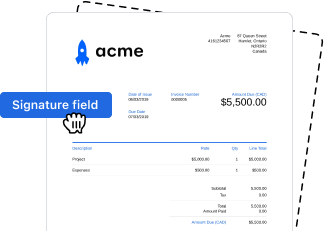Boost Digital Signature Legitimateness for NPOs in European Union with airSlate SignNow
- Quick to start
- Easy-to-use
- 24/7 support
Simplified document journeys for small teams and individuals




We spread the word about digital transformation
Why choose airSlate SignNow
-
Free 7-day trial. Choose the plan you need and try it risk-free.
-
Honest pricing for full-featured plans. airSlate SignNow offers subscription plans with no overages or hidden fees at renewal.
-
Enterprise-grade security. airSlate SignNow helps you comply with global security standards.







Your complete how-to guide - digital signature legitimateness for npos in european union
Digital Signature Legitimateness for NPOs in European Union
In today's digital age, ensuring the legitimacy of signatures is crucial for Nonprofit Organizations (NPOs) in the European Union. By utilizing digital signature solutions like airSlate SignNow, NPOs can streamline their signing processes while maintaining compliance with EU regulations.
Steps to Utilize airSlate SignNow for Secure Document Signing:
- Launch the airSlate SignNow web page in your browser.
- Sign up for a free trial or log in.
- Upload a document you want to sign or send for signing.
- If you're going to reuse your document later, turn it into a template.
- Open your file and make edits: add fillable fields or insert information.
- Sign your document and add signature fields for the recipients.
- Click Continue to set up and send an eSignature invite.
airSlate SignNow empowers NPOs to efficiently manage their signing processes while ensuring the legitimacy of digital signatures in the European Union. With user-friendly features and cost-effective solutions, NPOs can benefit from the ease of use offered by airSlate SignNow.
Experience the benefits of airSlate SignNow today to enhance your document signing processes and ensure compliance with EU regulations.
How it works
Rate your experience
What is the digital signature legitimateness for npos in european union
The digital signature legitimateness for non-profit organizations (NPOs) in the European Union refers to the legal recognition and validity of electronic signatures used by these entities. Under the eIDAS Regulation, which governs electronic identification and trust services, digital signatures are considered equivalent to handwritten signatures, provided they meet specific criteria. This framework ensures that NPOs can securely and legally sign documents electronically, enhancing efficiency and reducing paperwork.
How to use the digital signature legitimateness for npos in european union
NPOs can leverage the digital signature legitimateness by utilizing secure eSignature platforms like airSlate SignNow. To do this, organizations must first ensure that their digital signatures comply with eIDAS standards. Once compliant, NPOs can create, send, and sign documents electronically. Users can fill out forms online, request signatures from multiple parties, and manage the signed documents in a secure cloud environment. This process streamlines operations and maintains the legal integrity of the signed documents.
Steps to complete the digital signature legitimateness for npos in european union
Completing the digital signature legitimateness for NPOs involves several steps:
- Ensure compliance with eIDAS regulations for electronic signatures.
- Select a reliable eSignature platform, such as airSlate SignNow.
- Create the document that requires signatures.
- Fill out the document electronically, including any necessary fields.
- Send the document for signature to the relevant parties.
- Once all parties have signed, securely store the completed document.
By following these steps, NPOs can effectively utilize digital signatures while ensuring legal compliance.
Legal use of the digital signature legitimateness for npos in european union
The legal use of digital signatures for NPOs in the European Union is governed by the eIDAS Regulation, which establishes the framework for electronic signatures. This regulation ensures that qualified electronic signatures have the same legal standing as traditional handwritten signatures. NPOs must ensure that they use a qualified trust service provider to issue their digital signatures if they wish to achieve the highest level of legal assurance. This legal backing allows NPOs to engage in contracts, agreements, and other formal documents with confidence.
Security & Compliance Guidelines
When utilizing digital signatures, NPOs must adhere to specific security and compliance guidelines to protect sensitive information and maintain legal validity. Key guidelines include:
- Use strong encryption methods to secure documents and signatures.
- Choose a reputable eSignature provider that complies with eIDAS regulations.
- Implement access controls to ensure that only authorized personnel can sign documents.
- Regularly audit and monitor the eSignature process for compliance and security breaches.
Following these guidelines helps NPOs safeguard their digital signing processes while ensuring compliance with legal standards.
-
Best ROI. Our customers achieve an average 7x ROI within the first six months.
-
Scales with your use cases. From SMBs to mid-market, airSlate SignNow delivers results for businesses of all sizes.
-
Intuitive UI and API. Sign and send documents from your apps in minutes.
FAQs
-
What is the digital signature legitimateness for NPOs in the European Union?
The digital signature legitimateness for NPOs in the European Union is governed by the eIDAS Regulation, which ensures that electronic signatures are legally recognized across member states. This means that NPOs can confidently use digital signatures for their documents, ensuring compliance and security. airSlate SignNow provides a solution that adheres to these regulations, making it easier for NPOs to operate efficiently.
-
How does airSlate SignNow ensure compliance with digital signature legitimateness for NPOs in the EU?
airSlate SignNow ensures compliance with digital signature legitimateness for NPOs in the EU by utilizing advanced encryption and authentication methods that meet eIDAS standards. Our platform is designed to provide a secure environment for signing documents, ensuring that all signatures are legally binding. This compliance helps NPOs streamline their operations while maintaining legal integrity.
-
What features does airSlate SignNow offer to support digital signature legitimateness for NPOs in the EU?
airSlate SignNow offers features such as customizable templates, audit trails, and secure storage to support digital signature legitimateness for NPOs in the EU. These features not only enhance the signing experience but also provide necessary documentation for legal compliance. By using our platform, NPOs can ensure that their digital signatures are valid and recognized.
-
Is airSlate SignNow cost-effective for NPOs looking for digital signature solutions?
Yes, airSlate SignNow is a cost-effective solution for NPOs seeking digital signature legitimateness for NPOs in the European Union. Our pricing plans are designed to accommodate the budgets of non-profit organizations, providing them with access to essential features without breaking the bank. This affordability allows NPOs to implement digital signatures efficiently.
-
Can airSlate SignNow integrate with other tools used by NPOs?
Absolutely! airSlate SignNow can seamlessly integrate with various tools commonly used by NPOs, enhancing the digital signature legitimateness for NPOs in the European Union. Whether it's CRM systems, document management software, or cloud storage solutions, our integrations help streamline workflows and improve efficiency. This flexibility makes it easier for NPOs to adopt digital signatures.
-
What are the benefits of using airSlate SignNow for digital signatures in NPOs?
Using airSlate SignNow for digital signatures provides numerous benefits for NPOs, including enhanced security, improved efficiency, and legal compliance. The digital signature legitimateness for NPOs in the European Union ensures that all signed documents are valid and enforceable. Additionally, our user-friendly interface allows NPOs to manage their documents effortlessly.
-
How can NPOs get started with airSlate SignNow for digital signatures?
NPOs can easily get started with airSlate SignNow by signing up for a free trial on our website. This allows organizations to explore the features and understand how digital signature legitimateness for NPOs in the European Union can benefit their operations. Once ready, they can choose a pricing plan that suits their needs and begin using our platform.
Related searches to digital signature legitimateness for npos in european union
Join over 28 million airSlate SignNow users
Get more for digital signature legitimateness for npos in european union
- Ensuring Compliance with Digital Signature Lawfulness ...
- Ensuring Digital Signature Lawfulness for Accounting ...
- Digital Signature Lawfulness for Communications & Media ...
- Ensuring Digital Signature Lawfulness for ...
- Ensuring Digital Signature Lawfulness for ...
- Ensuring Digital Signature Lawfulness for ...
- Understanding the digital signature lawfulness for ...
- Understanding the Lawfulness of Digital Signatures for ...




























